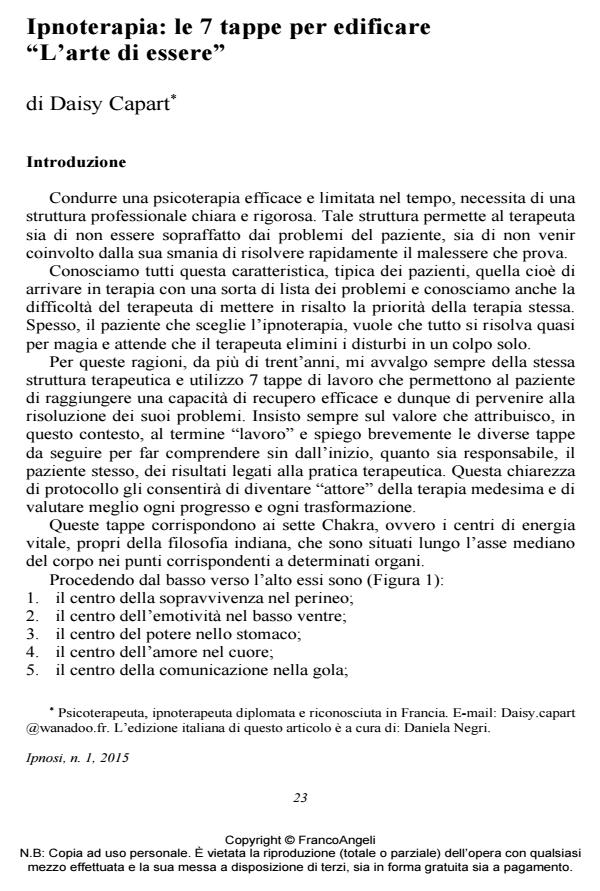Ipnoterapia: le 7 tappe per edificare "L’arte di essere"
Titolo Rivista IPNOSI
Autori/Curatori Daisy Capart
Anno di pubblicazione 2015 Fascicolo 2015/1 Lingua Italiano
Numero pagine 15 P. 23-37 Dimensione file 118 KB
DOI 10.3280/IPN2015-001002
Il DOI è il codice a barre della proprietà intellettuale: per saperne di più
clicca qui
Qui sotto puoi vedere in anteprima la prima pagina di questo articolo.
Se questo articolo ti interessa, lo puoi acquistare (e scaricare in formato pdf) seguendo le facili indicazioni per acquistare il download credit. Acquista Download Credits per scaricare questo Articolo in formato PDF

FrancoAngeli è membro della Publishers International Linking Association, Inc (PILA)associazione indipendente e non profit per facilitare (attraverso i servizi tecnologici implementati da CrossRef.org) l’accesso degli studiosi ai contenuti digitali nelle pubblicazioni professionali e scientifiche
During the ESH congress at Sorrento, the author had the opportunity to present the benefits of her 30 years of experience in the domain of Hypnosis and Hypnotherapy: In this article, she shares her personal method with other therapists to let them discover how efficient the techniques are and how lasting the results are. Be it for a lack of capacity of resilience or to develop inner forces and resources, the author uses always the same seven steps structure for her therapies to allow the patient to fully recover his/her capabilities and consequently to find a solution to his/her problems. These steps correspond to the seven centers of vital energy, called "chakras" in the Indian philosophy; centers that are located along the body’s spinal axis at spots that correspond to specific organs. During the hypnosis session, using adapted metaphors, the therapist progresses step by step to unlock and reinforce these centers. Such a method allows the therapist to follow a protocol that is unambiguous and thus prevents her from being drawn into the patient’s misinterpretation of his/her problems. This method allows the patient to assess his/her own improvements during the course of the therapy.;
Keywords:Struttura, ipnosi, 7 chakra, metafore, rinforzo della personalità, risorse.
- Anodea J. (2009). I chakra. Milano: Armenia.
- Bandler R., Grinder J. (1980). La metamorfosi terapeutica. Roma: Astrolabio.
- Casula C. (1997). I porcospini di Schopenhauer. Milano: Franco Angeli.
- Casula C. (2005). 7 Meditazioni guidate. Rimini: Red.
- Covey S. (2014). I sette pilastri del successo. Roma: Bompiani.
- Ducci G. (2013). “Ipnosi e neuroscienze: un minimo comune denominatore per la psicoterapia?”. Paestum: II Congresso SIIPE (testo non pubblicato). Erickson H.M. (1984). Guarire con l’ipnosi. Roma: Astrolabio.
- Faravelli C. (2010). Psicofarmacologia per Psicologi. Bologna: Il Mulino.
- Frost R.O., Steketee G. (2012). Tengo tutto. Perché non si riesce a buttare via niente. Trento: Erickson.
- Giberti F., Rossi R. (2007). Manuale di Psichiatria. Padova: Piccinin.
- Haye L.L. (1992). Guarire la tua vita. Milano: Edizioni Armenia.
- Hellenberger H.F. (1976). La scoperta dell’inconscio. Torino: Universale Bollati Boringhieri.
- Jampolsky G. (1985). Amore è lasciare andare la paura. Forlì-Cesena: Macro.
- Janet P. (1903). Les obsessions et la Psichastenie. Parigi: Alcan.
- Marks I.M., Lelliot P.P., Basoglu M., Noshirvani H., Monteiro W., Cohen D., Kasvikis Y. (1988). Clomipramine, self-exposure and therapist-aided exposure for obsessive-compulsive rituals. British Journal of Psychiatry, 152:522-534. DOI: 10.1192/bjp.152.4.522
- Rizzolatti G., Vozza L. (2008). Nella mente degli altri. Bologna: Zanichelli.
- Tamarin G.R. (1977). Some formal logical and social specicities of the obsessive and paranoid life style and though organization. Isr Ann Psychiatry Relate Disciplines, 15(1): 1-11.
- Yaryura J.A., Neziroglu F.A. (2001). Lo spettro dei Disturbi Ossessivo-Compulsivi. Torino: Centro Scientifico Editore.
Daisy Capart, Ipnoterapia: le 7 tappe per edificare "L’arte di essere" in "IPNOSI" 1/2015, pp 23-37, DOI: 10.3280/IPN2015-001002